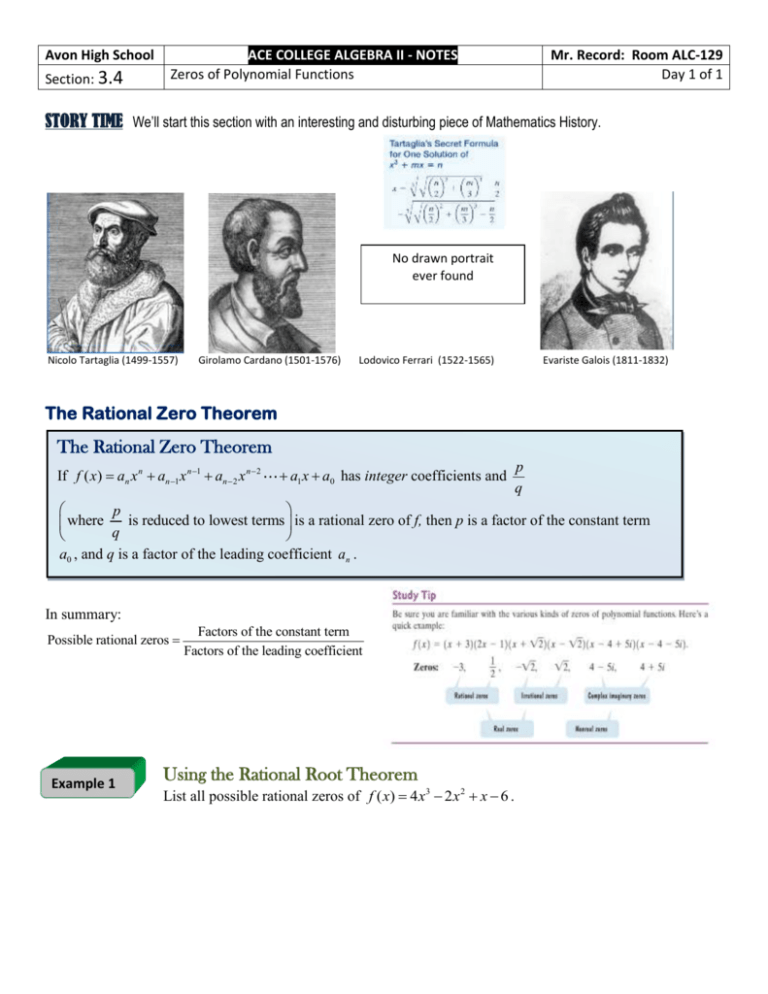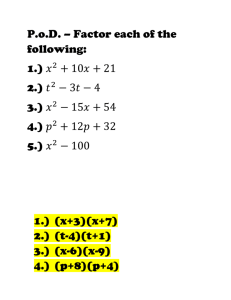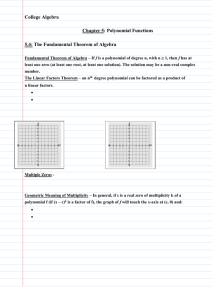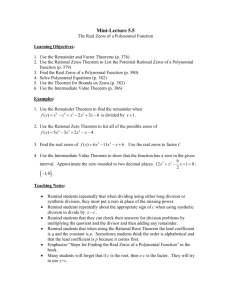3.4 - Zeros of Polynomial Functions
advertisement

Avon High School Section: 3.4 ACE COLLEGE ALGEBRA II - NOTES Zeros of Polynomial Functions Mr. Record: Room ALC-129 Day 1 of 1 STORY TIME We’ll start this section with an interesting and disturbing piece of Mathematics History. No drawn portrait ever found Nicolo Tartaglia (1499-1557) Girolamo Cardano (1501-1576) Lodovico Ferrari (1522-1565) Evariste Galois (1811-1832) The Rational Zero Theorem The Rational Zero Theorem If f ( x) an x n an 1 x n 1 an 2 x n 2 a1 x a0 has integer coefficients and p q p is reduced to lowest terms is a rational zero of f, then p is a factor of the constant term where q a0 , and q is a factor of the leading coefficient an . In summary: Possible rational zeros Example 1 Factors of the constant term Factors of the leading coefficient Using the Rational Root Theorem List all possible rational zeros of f ( x) 4 x3 2 x 2 x 6 . Example 2 Example 3 Example 4 Finding Zeros of a Polynomial Function Find all zeros of f ( x) x3 8x 2 11x 20 . Finding Zeros of a Polynomial Function Find all zeros of f ( x) x3 x 2 5 x 2 . Solving a Polynomial Equation Solve x 4 6 x3 22 x 2 30 x 13 0 Properties of Roots of Polynomial Equations 1. If a polynomial equation is of degree n, then counting multiple roots separately, the solution has n roots. 2. If a bi is a root of a polynomial equation with real coefficients ( b 0 ), then the imaginary number a bi is also a root. Imaginary roots, if they exist, occur in conjugate pairs. The Fundamanetal Theorem of Algebra In 1799, a 22-year old student named Carl Friedrich Gauss discovered the following theorem. The Fundamental Theorem of Algebra If f ( x) is a polynomial of degree n, where n 1, then the equation f ( x) 0 has at least one complex root. Carl Friedrich Gauss (1777-1855) The Linear Factorization Theorem The Linear Factorization Theorem If f ( x) an x n an 1 x n 1 an 2 x n 2 a1 x a0 , where n 1 and an 0 , then f ( x) an ( x c1 )( x c2 ) ( x cn ), where c1 , c2 , cn are complex numbers (possibly real and not necessarily distinct). In other words, an nth degree polynomial can be expressed as the product of a nonzero constant and n linear factors, where each linear factor has a leading coefficient of 1. number is also a root. Imaginary roots, if they exist, occur in conjugate pairs. Example 5 Finding a Polynomial Function with Given Zeros Find a fourth-degree polynomial function f ( x) with real coefficients that has 3, 2, and 1 i as roots. Descartes’s Rule of Signs Descartes’s Rule of Signs Let f ( x) an x n an 1 x n 1 an 2 x n 2 a1 x a0 be a polynomial with real coefficients. 1. The number of positive real zeros of f is either a. the same as the number of sign changes of f ( x) or b. less than the the number of sign changes of f ( x) by a positive even integer. If f ( x) has only one variation in sign, then f has exactly one positive real zero. 2. The number of negative real zeros of f is either a. the same as the number of sign changes of f ( x) or b. less than the the number of sign changes of f ( x) by a positive even integer. If f ( x) has only one variation in sign, then f has exactly one negative real zero. Example 6 Using Descartes’s Rule of Signs Determine the possible numbers of positive and negative real zeros of f ( x) x 4 14 x3 71x 2 154 x 120 .









